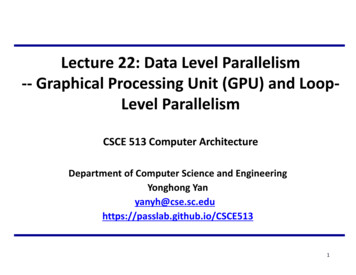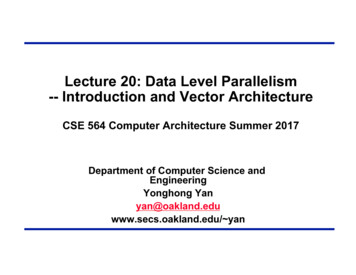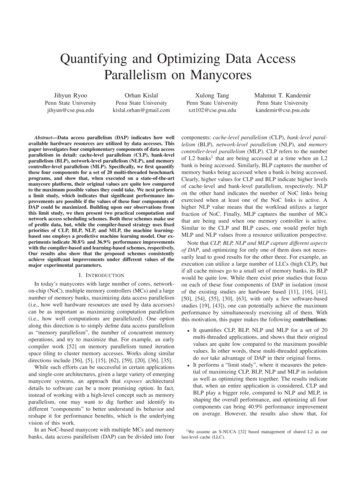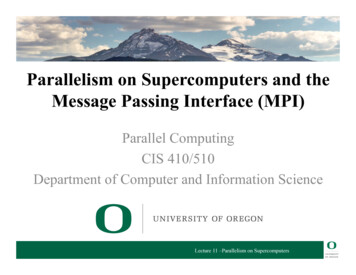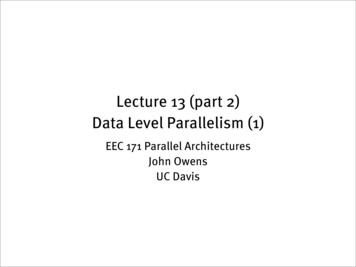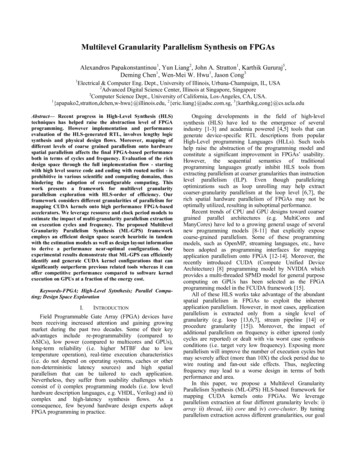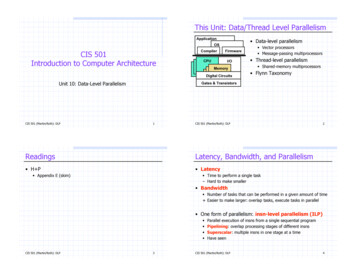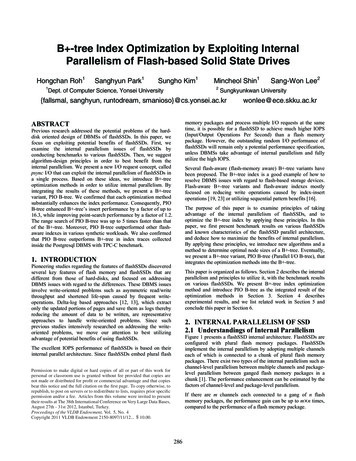
Transcription
Lecture 21: Data Level Parallelism-- SIMD ISA Extensions for Multimedia andRoofline Performance ModelCSCE 513 Computer ArchitectureDepartment of Computer Science andEngineeringYonghong 13
Topics for Data Level Parallelism (DLP)§ Parallelism (centered around )– Instruction Level Parallelism– Data Level Parallelism– Thread Level Parallelism§ DLP Introduction and Vector Architecture– 4.1, 4.2§ SIMD Instruction Set Extensions forMultimedia– 4.3§ Graphical Processing Units (GPU)– 4.4§ GPU and Loop-Level Parallelism and Others– 4.4, 4.52
SIMD Instruction Set extensionfor MultimediaTextbook: CAQA 4.33
What is Multimedia§ Multimedia is a combination oftext, graphic, sound,animation, and video that isdelivered interactively to theuser by electronic or digitallymanipulated os contains frame (images)4
Image Format and Processing§ Pixels– Images are matrix of pixels§ Binary images– Each pixel is either 0 or 15
Image Format and Processing§ Pixels– Images are matrix of pixels§ Grayscale images– Each pixel value normally range from 0 (black) to 255 (white)– 8 bits per pixel6
Image Format and Processing§ Pixels– Images are matrix of pixels§ Color images– Each pixel has three/four values (4 bits or 8 bits each) eachrepresenting a color scale7
Image Processing§ Mathematical operations by using any form of signalprocessing– Changing pixel values by matrix operations8
Image Processing: The major of the .htmlhttps://en.wikipedia.org/wiki/Kernel (image processing)9
Image Data Format and Processing forSIMD Architecture§ Data element– 4, 8, 16 bits (small)§ Same operations applied to every element(pixel)– Perfect for data-level parallelismCan fit multiple pixels in a regular scalarregister–E.g. for 8 bit pixel, a 64-bit register can take8 of them10
Multimedia Extensions (aka SIMDextensions) to Scalar ISA64b32b32b16b8b§§16b8b8b16b8b8b16b8b8b8bVery short vectors added to existing ISAs for microprocessorsUse existing 64-bit registers split into 2x32b or 4x16b or 8x8b– Lincoln Labs TX-2 from 1957 had 36b datapath split into 2x18b or 4x9b– Newer designs have wider registers» 128b for PowerPC Altivec, Intel SSE2/3/4» 256b for Intel AVX§Single instruction operates on all elements within register16b16b16b4x16b adds16b16b16b16b16b 16b16b16b16b11
A Scalar FU to A Multi-Lane SIMD Unit§ Adder– Partitioning thecarry chains12
MMX SIMD Extensions to X86§ MMX instructions added in 1996– Repurposed the 64-bit floating-point registers to perform 8 8bit operations or 4 16-bit operations simultaneously.– MMX reused the floating-point data transfer instructions toaccess memory.– Parallel MAX and MIN operations, a wide variety of maskingand conditional instructions, DSP operations, etc.§ Claim: overall speedup 1.5 to 2X for 2D/3D graphics,audio, video, speech, comm., .– use in drivers or added to library routines; no compiler 13
MMX Instructions§ Move 32b, 64b§ Add, Subtract in parallel: 8 8b, 4 16b, 2 32b– opt. signed/unsigned saturate (set to max) if overflow§ Shifts (sll,srl, sra), And, And Not, Or, Xorin parallel: 8 8b, 4 16b, 2 32b§ Multiply, Multiply-Add in parallel: 4 16b§ Compare , in parallel: 8 8b, 4 16b, 2 32b– sets field to 0s (false) or 1s (true); removes branches§ Pack/Unpack– Convert 32b – 16b, 16b – 8b– Pack saturates (set to max) if number is too large14
SSE/SSE2/SSE3 SIMD Extensions to X86§ Streaming SIMD Extensions (SSE) successor in 1999– Added separate 128-bit registers that were 128 bits wide» 16 8-bit operations, 8 16-bit operations, or 4 32-bit operations.» Also perform parallel single-precision FP arithmetic.– Separate data transfer instructions.– double-precision SIMD floating-point data types via SSE2 in2001, SSE3 in 2004, and SSE4 in 2007.» increased the peak FP performance of the x86 computers.– Each generation also added ad hoc instructions to acceleratespecific multimedia functions.15
AVX SIMD Extensions for X86§ Advanced Vector Extensions (AVX), added in 2010§ Doubles the width of the registers to 256 bits– double the number of operations on all narrower data types.Figure 4.9 shows AVX instructions useful for doubleprecision floating-point computations.§ AVX includes preparations to extend to 512 or 1024bits bits in future generations of the architecture.16
DAXPYdouble a, X[], Y[]; // 8-byte per elementfor (i 0; i 32; i )Y[i] a* X[i] Y[i];§ 256-bit SIMD exts toRISC-V èRVP– 4 double FP§ RV64G: 258 insts§ SIMD RVP: 67insts– 8 Loop iterations– 4 reduction§ RV64V: 8 instrs– 30 reduction17
Multimedia Extensions versus Vectors§ Limited instruction set:– no vector length control– no strided load/store or scatter/gather– unit-stride loads must be aligned to 64/128-bit boundary§ Limited vector register length:– requires superscalar dispatch to keep multiply/add/load unitsbusy– loop unrolling to hide latencies increases register pressure§ Trend towards fuller vector support inmicroprocessors– Better support for misaligned memory accesses– Support of double-precision (64-bit floating-point)– New Intel AVX spec (announced April 2008), 256b vectorregisters (expandable up to 1024b)1818
Programming Multimedia SIMD Architectures§ The easiest way to use these instructions has beenthrough libraries or by writing in assembly language.– The ad hoc nature of the SIMD multimedia extensions,§ Recent extensions have become more regular– Compilers are starting to produce SIMD instructionsautomatically.» Addvanced compilers today can generate SIMD FP instructionsto deliver much higher performance for scientific codes.» Memory alignment is still an important factor for performance19
Why are Multimedia SIMD Extensions soPopular§ Cost little to add to the standard arithmetic unit andthey were easy to implement.§ Require little extra state compared to vectorarchitectures, which is always a concern for contextswitch times.§ Does not requires a lot of memory bandwidth tosupport as what a vector architecture requires.§ Others regarding to the virtual memory and cachethat make SIMD extensions less challenging thanvector architecture.The state of the art is that we are putting a fullor advanced vector capability to multi/manycoreCPUs, and Manycore GPUs20
State of the Art: Intel Xeon Phi ManycoreVector Capability§ Intel Xeon Phi Knight Corner, 2012, 60 cores, 4-way SMT§ Intel Xeon Phi Knight Landing, 2016, 60 cores, 4-way SMT and HBM– http://www.hotchips.org/wp-content/uploads/hc agazine-AE-PR-12-14-32.pdf21
The Picture I drew on the blackBoard22
State of the Art: ARM Scalable VectorExtensions (SVE)§ Announced in August 2016– tension-sve-forthe-armv8-a-architecture– http://www.hotchips.org/wpcontent/uploads/hc M-v8-23 51-v11.pdf§ Beyond vector architecture we learned– Vector loop, predict and speculation– Vector Length Agnostic (VLA) programming– Check the slide23
The Roofline Visual Performance Model§ Self-study if you are interested: two pages of textbook– Useful, simple and interesting§ More materials:– Slides: https://crd.lbl.gov/assets/pubs presos/parlab08roofline-talk.pdf– Paper:https://people.eecs.berkeley.edu/ waterman/papers/roofline.pdf– Website: R/research/roofline/24
Image Data Format and Processing for SIMD Architecture §Data element -4, 8, 16 bits (small) §Same operations applied to every element (pixel) -Perfect for data-level parallelism Can fit multiple pixels in a regular scalar register -E.g. for 8 bit pixel, a 64-bit register can take 8 of them
